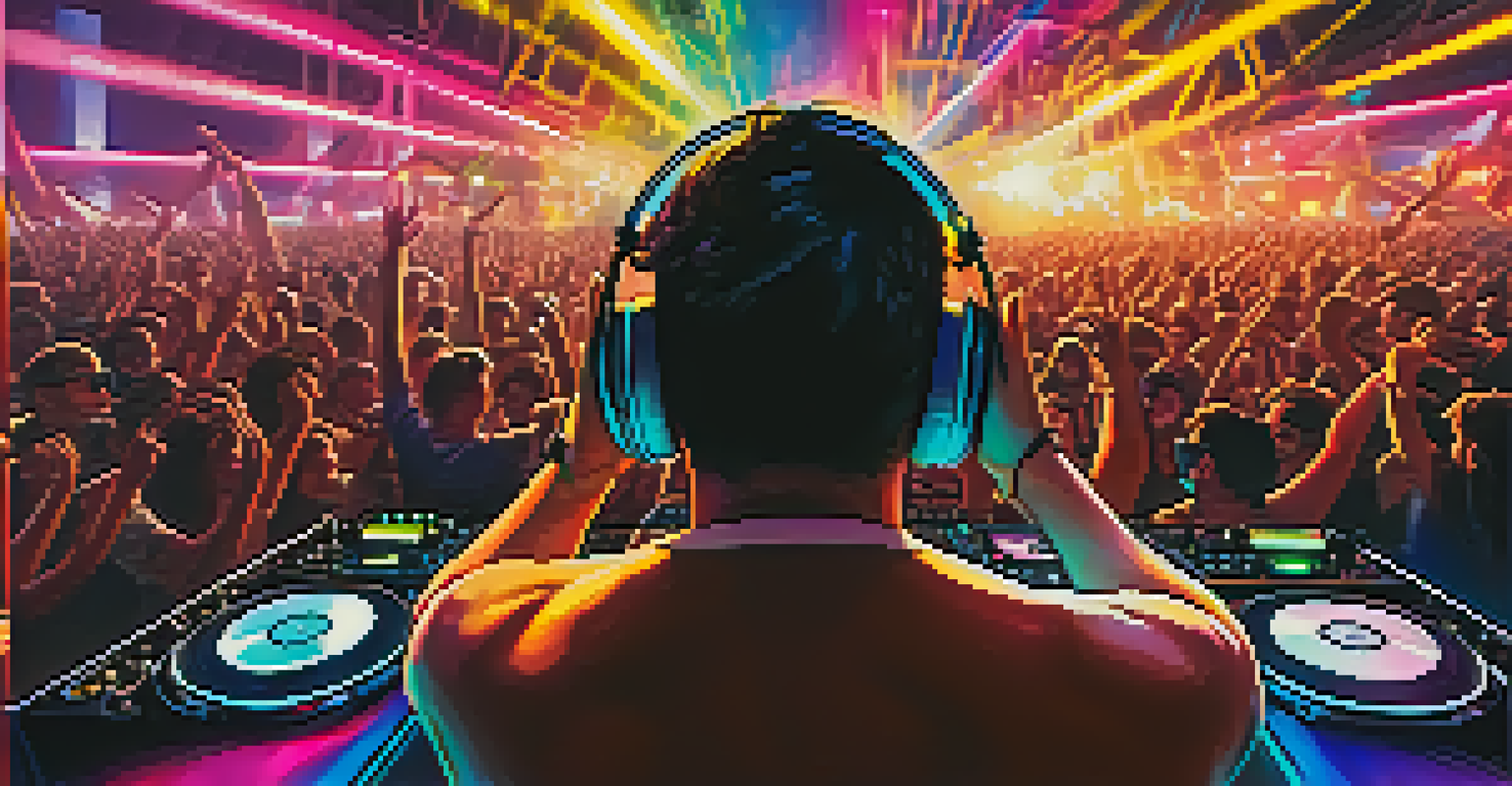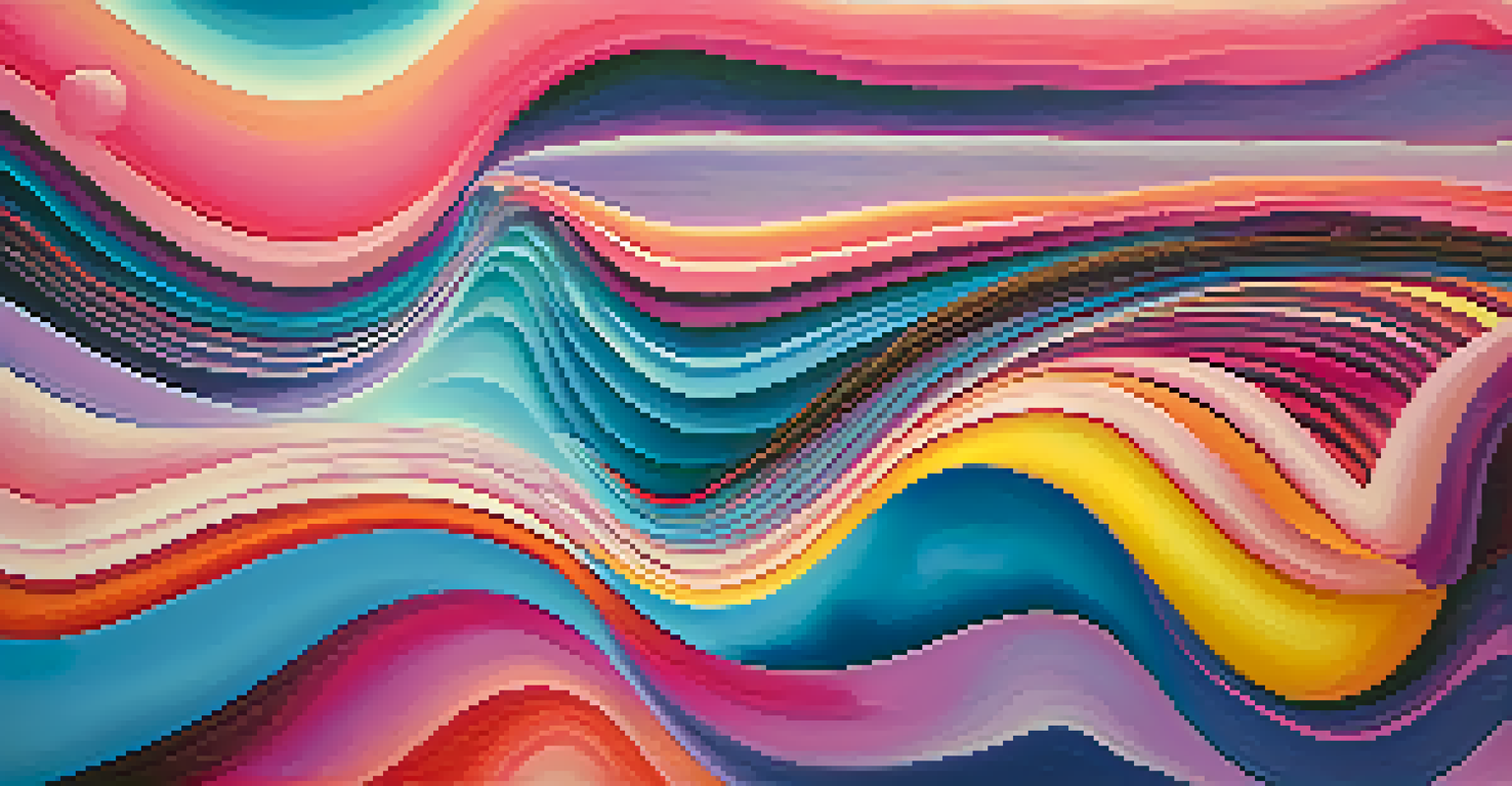Hallucinogens and the Evolution of Electronic Dance Music

Understanding Hallucinogens: A Brief Overview
Hallucinogens are substances that significantly alter perception, mood, and cognitive processes. Common examples include LSD, psilocybin mushrooms, and mescaline. These substances have been used for centuries, often in spiritual or ritualistic contexts, to expand consciousness and deepen experiences.
The psychedelic experience can be a doorway to a deeper understanding of reality.
In the last century, however, hallucinogens transitioned from traditional uses to becoming part of modern youth culture, particularly during the 1960s and '70s. This shift coincided with the rise of countercultural movements that embraced freedom of expression and exploration of the mind. As society began to question norms, music became a primary outlet for this burgeoning consciousness.
The connection between hallucinogens and music is profound, as many artists have cited altered states of consciousness as inspiration for their work. This relationship laid the groundwork for the eventual fusion of these elements in the realm of electronic dance music, or EDM.
The Birth of Electronic Dance Music: A Cultural Shift
Electronic dance music emerged in the late 1970s and early 1980s as a new genre, characterized by repetitive beats, synthesized sounds, and an emphasis on rhythm over melody. This marked a significant departure from traditional music forms, allowing for experimentation and innovation. Early pioneers like Kraftwerk and Giorgio Moroder set the stage for what would become a global phenomenon.

As EDM began to gain traction, it aligned with the underground club scene, where music and dance became integral to social gatherings. These clubs often provided a safe haven for those looking to escape reality, and the experience was often enhanced by the use of hallucinogens. The pulsating beats and immersive sounds created an environment where physical and metaphysical experiences intertwined.
Hallucinogens Shape EDM Culture
The historical use of hallucinogens has profoundly influenced the evolution of electronic dance music, fostering creativity and a sense of community.
This synergy between hallucinogens and EDM fostered a sense of community among ravers, encouraging acceptance and exploration of consciousness. The dance floor became a space for connection, where people could express themselves without judgment, further solidifying EDM's roots in this cultural shift.
The Psychedelic Influence on EDM Soundscapes
The influence of hallucinogens on the soundscapes of EDM is both direct and indirect. Many producers and DJs draw inspiration from their psychedelic experiences, crafting tracks that evoke emotional and sensory responses. This can be seen in the use of lush melodies, complex sound layers, and evolving rhythms that mimic the journey of a hallucinogenic experience.
Music can change the world because it can change people.
Genres like psychedelic trance, which emerged in the late '90s, specifically aim to create a sonic experience that mirrors the effects of hallucinogens. These tracks often feature fast tempos, hypnotic beats, and surreal sound effects, creating an entrancing atmosphere that resonates with listeners. The goal is to transport the audience to an altered state of perception, mirroring the feeling of being on a psychedelic trip.
Moreover, many EDM festivals incorporate visual elements that enhance this experience, using light shows, projections, and immersive environments. These sensory enhancements serve to amplify the effects of both the music and any substances participants may choose to indulge in, creating a holistic experience that is both memorable and transformative.
Raves: A Modern-Day Psychedelic Experience
Raves are often viewed as the modern-day equivalent of the psychedelic experience, where hallucinogens and electronic music converge. These gatherings provide a space for self-expression, creativity, and communal experience, much like the spiritual rituals of the past. The atmosphere is charged with energy, encouraging participants to connect with themselves and one another.
The rave culture, which gained massive popularity in the '90s, embraced the use of substances like ecstasy (MDMA) alongside hallucinogens. The combination of these drugs with the euphoric beats of EDM created an exhilarating environment, often described as transcendent. Participants frequently report feelings of unity and love, enhancing the overall experience.
Raves as Psychedelic Gatherings
Raves serve as modern-day spaces for self-expression and connection, merging hallucinogenic experiences with the euphoric beats of EDM.
However, the intertwining of drugs and raves has also raised concerns about safety and the potential for substance abuse. While many rave-goers approach these experiences with a sense of caution, it’s essential to acknowledge the risks involved and promote responsible consumption, ensuring that the joy of dance and music remains a safe and inclusive celebration.
Key Artists Shaping the Hallucinogenic EDM Landscape
Several artists have significantly impacted the hallucinogenic EDM scene, weaving their own experiences into their music. For instance, the likes of Shpongle and Infected Mushroom specialize in creating eclectic soundscapes that reflect psychedelic themes. Their music often features intricate melodies and samples that transport listeners to otherworldly realms.
Similarly, artists like Tame Impala and Tycho blend elements of rock and ambient music with electronic influences, creating a unique sound that draws on psychedelic experiences. Their tracks often evoke a sense of nostalgia and introspection, encouraging listeners to explore their inner worlds. This cross-genre blending showcases how hallucinogens can inspire creativity across various musical landscapes.
As these artists continue to evolve, they push boundaries and redefine what EDM can be, often incorporating live instruments or organic sounds. This evolution not only honors the roots of psychedelic music but also invites a new generation to experience the profound connection between sound and consciousness.
The Role of Festivals in the Hallucinogenic EDM Experience
Festivals like Burning Man and Electric Daisy Carnival have become epicenters for the convergence of hallucinogens and EDM culture. These massive gatherings create immersive environments where music, art, and self-expression collide, often encouraging participants to explore altered states of consciousness. The festival experience is designed to be transformative, allowing attendees to break free from societal norms and embrace their true selves.
At these festivals, the use of hallucinogens is often prevalent, enhancing the overall experience of music and community. The shared experience of dancing under the stars, surrounded by art installations and like-minded individuals, fosters a profound sense of connection. This sense of belonging is a core aspect of the festival culture, often described as a spiritual awakening.
Festivals Enhance Hallucinogenic Experience
Major festivals like Burning Man and Electric Daisy Carnival create immersive environments that amplify the connection between music and altered states of consciousness.
Nonetheless, it’s important for festival-goers to prioritize safety and well-being. Many festivals have implemented harm reduction strategies, providing resources and education about responsible substance use. By creating an environment that emphasizes safety, the festival culture can continue to thrive, offering participants both joy and a deeper understanding of the human experience.
The Future: Sustaining the Connection Between EDM and Hallucinogens
As electronic dance music continues to evolve, the relationship between hallucinogens and the genre remains dynamic. With increasing interest in mental health and wellness, there is a growing conversation around the therapeutic potential of hallucinogens. This shift could influence how both artists and audiences approach the use of these substances within the context of EDM.
Moreover, the rise of virtual events and digital platforms has opened new avenues for experiencing EDM without the physical need for festivals. While the communal experience of in-person gatherings is irreplaceable, these virtual spaces can create new forms of connection and exploration, potentially reshaping the culture surrounding hallucinogens and music.

Ultimately, the future of EDM and hallucinogens will likely be characterized by a balance between exploration and responsibility. As artists, festival organizers, and attendees navigate this landscape, the focus will remain on fostering community, creativity, and a deeper understanding of consciousness through the powerful medium of music.